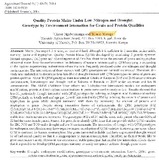| dc.contributor.author | Kiarie, Njoroge | |
| dc.contributor.author | Ngaboyisonga, Claver | |
| dc.date.accessioned | 2014-07-02T11:57:23Z | |
| dc.date.available | 2014-07-02T11:57:23Z | |
| dc.date.issued | 2014 | |
| dc.identifier.citation | Agricultural Journal 9 (1) : 68-76, 2014 | en_US |
| dc.identifier.issn | 18169155 | |
| dc.identifier.uri | http://hdl.handle.net/11295/71675 | |
| dc.description.abstract | Abstract: Maize (Zea Mays L.) is used as food and feed, although it is deficient in 2 essential amino acids, namely; lysine and tryptophan. Quality Protein Maize (QPM) developed by combining 2 genetic systems: Mutant opaque-2 (o2) gene and o2-endosperm modifiers has about twice the amount of lysine and tryptophan of normal maize. It can be used to correct the deficiency of maize in protein quality. QPM cropping is expanding in the regions experiencing malnutrition where maize is frequently produced under low-nitrogen and drought environments. The interactins of these stresses with QPM genotypes are not well understood. Therefore, this study was undertaken to determine how low-N and drought interact with QPM genotypes in terms of grain and protein qualities. About 36 QPM genotypes were evaluated at Kiboko in Kenya in 2005 and 2006 under optimum environments, low-nitrogen and drought and at Rubona in Rwanda in 2005 under optimum and low-N environments. The AMMI ( Additive Main effects and Multiplicative Interaction) models for endosperm modification, protein and tryptophan concentrations in grain were used to analyze data. Results showed that low-N, particularly drought interacted with QPM genotypes by reducing endosperm modification and making QPM partially or totally soft and opaque. Low-N interacted with QPM by reducing the amount of protein and tryptophan in grain. Despite strong interactive forces of environments, the QPM genotypes. G02 ([CML202/CML144]F2-1-1-3-B*4/[CML205/CML176]-B-2-1-B*3), G20([CML202/CML144 F2-66-2-3-B*4/[CML389/CML176]B-29-2-B*3) and G22([CML389/GQL5]B-22-1-B*3) were stable in all traits acress environments. The genotypes G02 and 20 had the same male parent whereas G20 and 22 had the same female parent. Hence, it is possible to identify QPM lines that can provide stable QPM varieties for EM, PCG and TCG under drought and low N environments. The interaction of drought with QPM genotypes for endosperm modification may have negative impact on adoption of QPM varieties in stress prone areas where QPM is destined for human consumption. The grain harvested in fields that have experienced drought would be of bad kernel quality so that it is inappropriate to human consumption. Therefore, no farmer would like to grow such maize variety. However, the existence of stable genotypes that exhibit low interaction effects shows that it is possible to develop QPM genotypes that may be easily acceptable in those drought prone areas. | en_US |
| dc.description.sponsorship | University of Nairobi | en_US |
| dc.language.iso | en | en_US |
| dc.publisher | University of Nairobi, Faculty of Agriculture | en_US |
| dc.relation.ispartofseries | Agricultural Journal;9 (1) : 68-76, 2014 | |
| dc.subject | Drought | en_US |
| dc.subject | endosperm modification | en_US |
| dc.subject | genotypesxenvironmentts interaction | en_US |
| dc.subject | Quality protein maize | en_US |
| dc.subject | Low-N | en_US |
| dc.subject | Grow | en_US |
| dc.title | Quality protein Maize under Low-Nitrogen and drought : | en_US |
| dc.title.alternative | Genotype by Enviroment interaction for grain and protein qualities | en_US |
| dc.type | Article | en_US |

